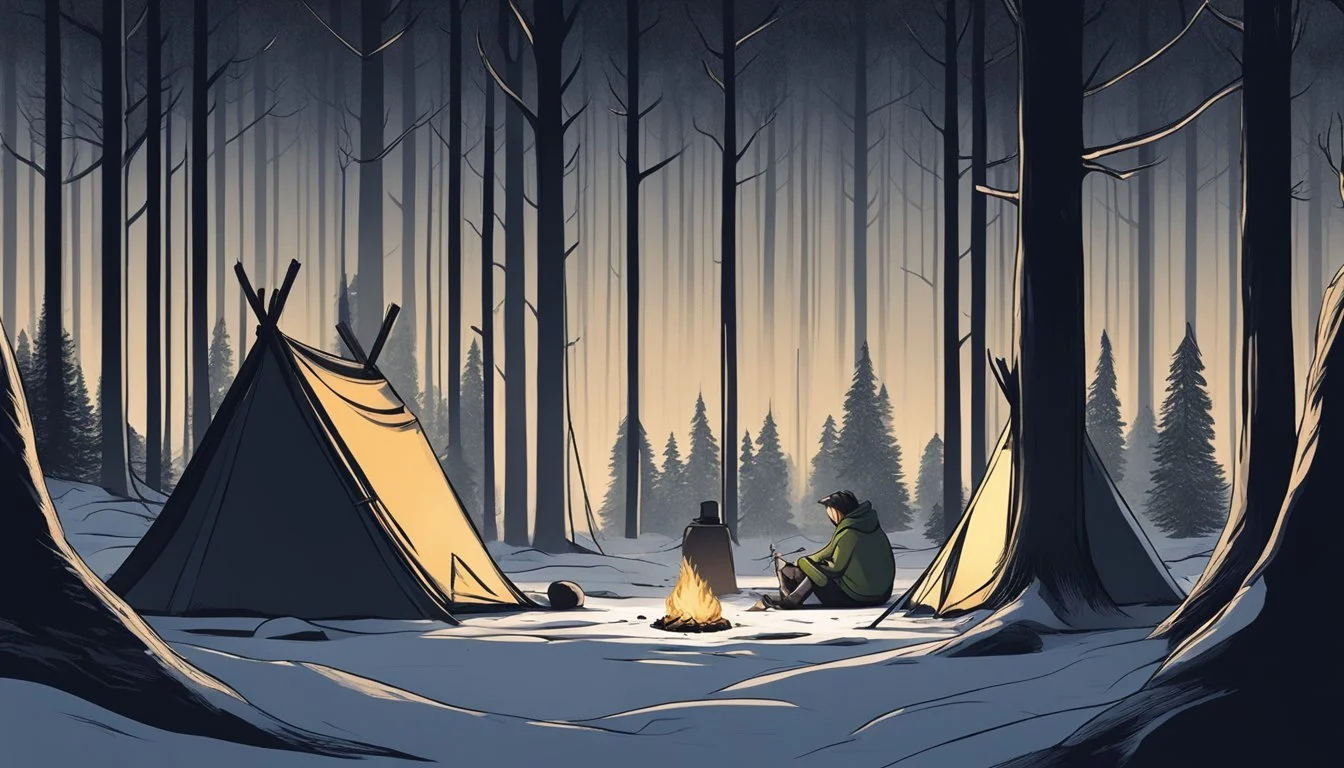PTSD and Trauma: Yellowstone's Approach to Character Development Enhances Realism in Western Drama
Yellowstone, the hit TV series created by Taylor Sheridan, offers a compelling exploration of PTSD and trauma through its nuanced character development. The show's approach to these sensitive topics provides viewers with a raw and authentic portrayal of the lasting effects of traumatic experiences.
Yellowstone's characters, particularly Kayce Dutton, serve as vehicles for examining the complexities of PTSD and its impact on individuals and relationships. Kayce's military background and subsequent struggles with flashbacks and emotional triggers illustrate the ongoing battle many face in the aftermath of trauma. The series doesn't shy away from depicting the harsh realities of living with PTSD, showcasing both the visible and invisible scars carried by those affected.
Through careful storytelling and character arcs, Yellowstone demonstrates how trauma shapes decision-making, influences interpersonal dynamics, and drives personal growth. This thoughtful integration of PTSD and trauma into the narrative fabric of the show adds depth to its characters and resonates with viewers who may have similar experiences or know someone who does.
Understanding PTSD and Its Representation in Media
Post-Traumatic Stress Disorder (PTSD) has become an important topic in media portrayals. Its depiction has evolved to reflect a more nuanced understanding of trauma and its effects on individuals.
Defining Trauma and PTSD
Trauma refers to deeply distressing or disturbing experiences that overwhelm an individual's ability to cope. PTSD is a mental health condition triggered by such traumatic events.
Symptoms of PTSD include flashbacks, nightmares, severe anxiety, and uncontrollable thoughts about the event. These can significantly impact daily functioning and relationships.
Media representations of trauma and PTSD have played a crucial role in shaping public perception. Accurate portrayals help increase awareness and reduce stigma surrounding mental health issues.
PTSD in the Landscape of Television
Television shows have increasingly incorporated PTSD into character development and storylines. This trend reflects a growing societal awareness of mental health issues.
Some TV series depict PTSD realistically, showcasing its complex effects on characters' lives. These portrayals often explore themes of resilience, healing, and the human capacity for recovery.
However, not all representations are accurate. Some shows may sensationalize or oversimplify PTSD for dramatic effect. This can perpetuate misconceptions about the disorder.
Responsible depictions of PTSD in television can educate viewers and foster empathy for those affected by trauma. They also highlight the importance of seeking professional help and support.
Yellowstone's Narrative and the Dutton Family Legacy
The Dutton family's multi-generational saga forms the core of Yellowstone's compelling narrative. Their complex relationships and struggles to maintain control of their vast ranch drive the series' dramatic arcs.
Foundations of the Dutton Family
The Dutton legacy traces back to 1883, when the family first established their roots in Montana. James and Margaret Dutton, the original settlers, laid the groundwork for the sprawling Yellowstone Ranch. Their determination and sacrifices set the stage for future generations.
John Dutton III, portrayed by Kevin Costner, now leads the family as the formidable patriarch. His iron-willed leadership stems from a deep connection to the land and a fierce desire to protect his family's heritage. This commitment shapes his actions and decisions throughout the series.
John's children - Beth, Jamie, and Kayce - each play crucial roles in the ongoing family drama. Their complex dynamics and individual struggles add layers of depth to the overarching narrative.
Conflict and Turmoil Among the Duttons
Internal strife plagues the Dutton family, creating tension that propels much of Yellowstone's plot. Beth's sharp wit and ruthless business acumen often clash with Jamie's political ambitions and inner conflicts. Kayce struggles to balance his loyalty to the ranch with his own family responsibilities.
The loss of Evelyn Dutton, John's wife, continues to impact family relationships years later. Her absence leaves a void that influences each character's motivations and actions.
External threats to the Yellowstone Ranch constantly test the Duttons' resolve. Land developers, rival ranchers, and political opponents all seek to chip away at their power and territory. These challenges force the family to present a united front despite their internal disagreements.
Character Studies: Trauma and Its Aftermath
Yellowstone's main characters grapple with deep-seated traumas that shape their personalities and drive their actions. Their experiences reveal the lasting impacts of past wounds on present behavior and relationships.
John Dutton's Burden of Leadership
John Dutton carries the weight of generational trauma as patriarch of the Yellowstone ranch. His stoic exterior masks scars from losing his wife and son. Flashbacks to these losses inform his fierce protectiveness of family and land.
John's trauma manifests in his controlling leadership style. He struggles to show vulnerability, often resorting to manipulation to maintain power. Yet glimpses of compassion emerge, especially toward his children.
His complex relationship with Jamie highlights John's difficulty processing grief. Unable to fully embrace his adopted son, John's unresolved trauma creates a rift between them.
Beth Dutton: Businesswoman and Survivor
Beth Dutton's trauma stems from a botched abortion in her youth. This experience left her unable to have children and deeply scarred emotionally. Her sharp tongue and aggressive business tactics serve as armor against further pain.
Despite her hard exterior, Beth shows moments of vulnerability with Rip. Their relationship represents her journey toward healing. Beth's trauma fuels her fierce loyalty to family and ruthless approach to perceived threats.
Her complex dynamic with Jamie reflects Beth's struggle to reconcile past betrayals. She channels her pain into protecting the ranch, often through morally questionable means.
Kayce Dutton: Navy SEAL and Ranch Hand
Kayce Dutton's trauma originates from his military service and family conflicts. His PTSD manifests in hypervigilance and occasional violent outbursts. Kayce's struggle to reintegrate into civilian life creates tension with his roles as father and rancher.
His marriage to Monica provides a source of stability, though their relationship is strained by Kayce's divided loyalties. Flashbacks to his time as a Navy SEAL inform his approach to protecting the ranch.
Kayce's compassionate nature often clashes with the harsh realities of ranch life. His journey involves reconciling his military past with his desire for a peaceful future.
The Transformation of Jamie Dutton
Jamie Dutton's trauma centers on his identity as an adopted child. Learning about his biological father triggers a profound identity crisis. This revelation exacerbates Jamie's existing insecurities and sense of alienation from the Dutton family.
His ambition and desire for approval drive Jamie to make questionable choices. The conflict between loyalty to his adoptive family and curiosity about his roots creates internal turmoil.
Jamie's transformation throughout the series reflects his struggle to define himself outside the Dutton legacy. His actions, both in support of and against the family, stem from this core trauma.
The Role of the Setting in Trauma Exposure
Yellowstone's rugged Montana landscape and the demanding lifestyle of the Dutton Ranch create an environment ripe for trauma exposure. The harsh wilderness and high-stakes ranching operations present constant physical and psychological challenges for the characters.
Montana's Majestic Yet Harsh Landscape
Montana's vast wilderness serves as a stunning backdrop for Yellowstone, but it also poses significant dangers. The remote terrain isolates characters, limiting access to help during emergencies. Extreme weather conditions like blizzards and wildfires threaten lives and livelihoods. Wildlife encounters, including bears and wolves, add another layer of risk.
Characters must remain vigilant against natural threats while navigating treacherous mountain passes and unpredictable rivers. This constant state of alertness can lead to heightened stress and anxiety, potentially increasing vulnerability to trauma.
Daily Life on the Yellowstone Dutton Ranch
The Yellowstone Dutton Ranch operates as a microcosm of intense physical labor and emotional pressure. Ranch hands face daily risks working with large animals and heavy machinery. Injuries are common, ranging from minor scrapes to life-threatening accidents.
Violence is an ever-present threat on the ranch. Conflicts with rival ranchers, land developers, and criminal elements often escalate into dangerous confrontations. The Dutton family's commitment to protecting their legacy puts them in constant opposition to external forces.
The ranch's insular nature amplifies interpersonal tensions. Long hours and close quarters can lead to explosive arguments and power struggles among workers and family members alike.
The Therapeutic Aspects of Yellowstone
Yellowstone explores healing and growth through its characters' relationships and experiences. The show depicts how individuals cope with trauma and find support in unexpected places.
Familial Bonds and Support Systems
The Dutton family demonstrates the power of familial bonds in overcoming adversity. John Dutton, despite his flaws, provides a steady presence for his children. Beth and Jamie, though often at odds, share moments of vulnerability that reveal their deep-seated need for connection.
Tate Dutton, played by Brecken Merrill, exemplifies resilience in the face of trauma. His parents, Kayce and Monica, work to create a nurturing environment for him. Their efforts showcase the importance of a stable support system in healing.
The ranch itself serves as a sanctuary for many characters, offering a sense of belonging and purpose.
Rip Wheeler: The Embodiment of Loyalty
Cole Hauser's portrayal of Rip Wheeler highlights the therapeutic power of unwavering loyalty. Rip's dedication to the Dutton family, particularly to Beth and John, demonstrates how steadfast relationships can anchor individuals struggling with past traumas.
Rip's journey from an orphaned boy to a trusted ranch foreman illustrates personal growth and redemption. His presence provides stability for other characters, especially in times of crisis.
The character's evolution serves as a testament to the healing potential of finding one's place within a chosen family.
Showcasing Vulnerability in Masculinity
Yellowstone challenges traditional notions of masculinity by allowing its male characters to display vulnerability. Kayce Dutton's struggles with PTSD from his military service are portrayed with sensitivity and depth.
The show explores how cowboys, often seen as symbols of stoic strength, grapple with emotional pain. Scenes of characters like Rip and Lloyd sharing quiet moments of camaraderie reveal the importance of male friendships in processing trauma.
By depicting these moments of vulnerability, Yellowstone illustrates that seeking help and expressing emotions are signs of strength, not weakness.
Cinematic Techniques and Storytelling Dynamics
Yellowstone employs powerful visual storytelling to portray PTSD and trauma. The show's cinematic approach blends suspenseful flashbacks with symbolic imagery to create a rich, layered narrative.
Crafting Suspense Through Flashbacks
Flashbacks serve as a crucial tool in Yellowstone's portrayal of PTSD. These scenes often appear abruptly, mirroring the intrusive nature of traumatic memories. The show uses quick cuts and disorienting camera work to heighten tension and convey characters' inner turmoil.
Lighting shifts and color grading help differentiate past from present. Flashbacks typically feature muted tones or stark contrasts, emphasizing their emotional weight. Sound design plays a key role, with muffled audio or sharp noises triggering memories.
The frequency and intensity of flashbacks evolve with character arcs, reflecting their struggles with trauma. This technique allows viewers to experience the characters' PTSD symptoms firsthand.
Symbolism and Branding: The Mark of the Duttons
The Yellowstone ranch's brand serves as a powerful symbol throughout the series. Its presence on characters' bodies represents both belonging and trauma. Close-up shots of the brand emphasize its significance in key moments.
The show uses visual motifs tied to the ranch to reinforce themes of legacy and sacrifice. Wide landscape shots contrast with intimate character moments, highlighting the connection between land and identity.
Recurring imagery, such as fire or specific animals, often carries symbolic weight. These elements appear in both present-day scenes and flashbacks, tying past traumas to current conflicts.
The Dutton brand becomes a visual shorthand for the family's complex history. Its appearance often signals moments of tension or character development related to trauma and loyalty.
Yellowstone's Impact and Viewer Reception
Yellowstone has made a significant mark on television, captivating audiences with its portrayal of complex characters and their struggles. The show's approach to PTSD and trauma resonates deeply with viewers.
Popularity and Ratings
Yellowstone has become the most popular drama series in the U.S. The show's viewership has grown consistently, with Season 4 and Season 5 drawing record-breaking audiences. Paramount Network reports millions of viewers tuning in for each episode.
The series has sparked a renaissance in Western-themed television. Its success has led to multiple spin-offs, expanding the Yellowstone universe and cementing its cultural impact.
Yellowstone's popularity extends beyond traditional TV. Clips and discussions about the show frequently trend on YouTube, indicating strong online engagement.
Critics' Views on PTSD and Trauma Portrayals
Critics have praised Yellowstone's nuanced depiction of PTSD and trauma, particularly through characters like Kayce Dutton. The show's portrayal of a military veteran grappling with past experiences has been noted for its authenticity.
Reviewers highlight how Yellowstone weaves trauma into character development. Flashbacks and emotional triggers reveal the depth of characters' struggles, adding layers to their actions and decisions.
Some critics argue that the show's intense storytelling and character arcs contribute to its addictive nature. The exploration of psychological impacts resonates with viewers, fostering a strong emotional connection to the series.






